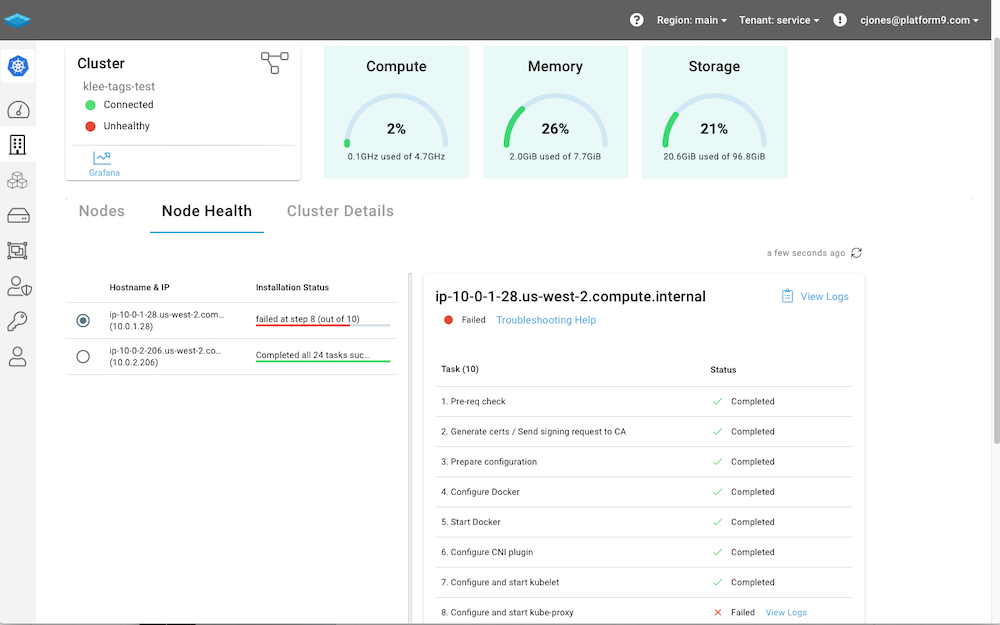Platform9 Releases Managed KubeVirt Solution to Unify VMs and Kubernetes Stacks
Platform9 aims to provide enterprises a complete SaaS management plane for Kubernetes . Platform9 Managed KubeVirt offers a unified platform to run virtual machines alongside containers.
Platform9 is looking to provide enterprises a complete SaaS management plane for Kubernetes.
The Platform9 Managed KubeVirt (PMK) provides a unified platform to run virtual machines (VMs) alongside containers, filling in some gaps IT uncovers when using traditional virtualization solutions.
KubeVirt is an open-source project that enables VMs to be managed by Kubernetes alongside containers. Platform9 Managed KubeVirt is a cloud service that makes deploying and managing KubeVirt seamless, allowing operators to focus on projects and applications that impact the business, according to Platform9 execs.
“Traditional virtualization solutions are expensive and managing a virtualization stack in addition to Kubernetes is complex and error-prone,” said Madhura Maskasky, VP of Product at Platform9. “With Platform9 Managed KubeVirt, developers get the best of both worlds without having to port all of your applications to containers or manage two entirely separate stacks.” It is offered as a 100% open-source solution to avoid vendor lock-in.
Maskasky also noted that virtualization platforms are not always suitable for disciplines where performance matters, such as edge computing, telco/5G, and machine learning. To fill this gap, “Platform9 Managed KubeVirt makes deploying and managing KubeVirt seamless, allowing end-users to focus on the projects and applications that impact their business, he added.

The Platform9 Managed KubeVirt sports these core features/functionality:
- VMs & Containers Converged: Single platform reduces complexity and costs
- Upstream Kubernetes & Add-Ons: PMK is a complete K8s platform including monitoring, logging, upgrades, CVE patching and more
- Run VMs natively in Kubernetes using KubeVirt: One-click to add KubevVirt to any cluster and run VMs alongside containers.
- On-premises/edge runs on Metal: Complete control from bare metal servers to Kubernetes. containers and virtualization
- Automated monitoring for VMs using built-in per cluster Prometheus instance
- SR-IOV and OVS-DPDK support for performance-sensitive applications
- VM management for image preset and snapshot management
- Enterprise-readiness capabilities for RBAC, multi-tenancy, and resource utilization quotas
- Guaranteed 99.9% uptime SLA through shared visibility, governance, and control across thousands of locations
Inside Platform9’s Commitment to KubeVirt
An excerpt from a Platform9 technical whitepaper, KubeVirt: How to Run VMs on Kubernetes explains how Platform9 allows users to deploy virtual machines (VMs) on Kubernetes clusters.
In the world of DevOps and software development, one of the challenges is bridging the gap between your containerized environments and your virtual machine environment.
While it’s not impossible, configuring the connection between your containers and your other services isn’t trivial either.Fortunately, you can use KubeVirt to bring your virtual machines into your container environment, which opens a whole new world of possibility and ease. With VMs, you can now deploy non-containerized applications and run them alongside your cloud-native applications, on a single Kubernetes cluster.
KubeVirt is an open-source project that allows you to create virtual machines within a Kubernetes cluster. The project was initiated by RedHat in 2016. It has since been open-sourced and was inducted into the Cloud Native Computing Foundation’s (CNCF) Sandbox Project, on September 9th, 2019.
KubeVirt is a collection of custom resource definitions (CRDs) and controllers. With KubeVirt, you can use the Kubernetes platform to run and manage application containers and VMs side-by-side. Under the surface, KubeVirt leverages QEMU and KVM to power the virtual machines. An overwhelming advantage of this approach is that all the tools and utilities you use to manage and maintain your cluster, apply to the KubeVirt VMs as well.
In this manner, with Platform9 Managed KubeVirt users can use the native Kubernetes functions to set up and control: Scheduling, Storage, Networking, Monitoring and Orchestration.
To simplify the complete DevOps process, Platform9 Managed KubeVirt also comes with:
- IPv6 support for all native services and users’ Kubernetes clusters
- API-driven automated IP address management (IPAM) out of the box
- Multiple high-performance networking options: SR-IOV, DPDK, PCI-passthrough, MACvLan, and IPvLAN
Readers can learn more about Platform9 Managed KubeVirt here.






